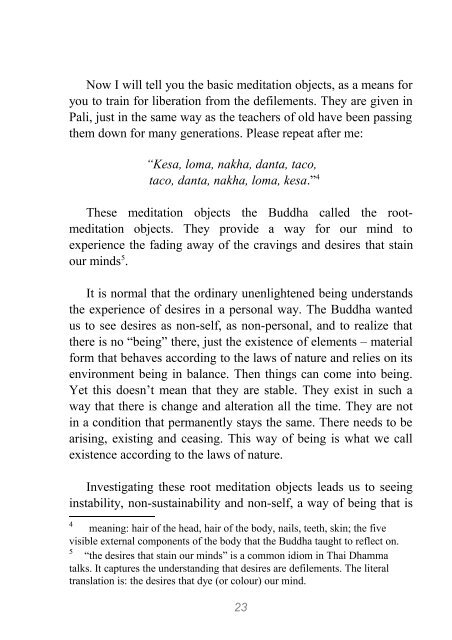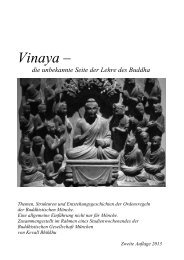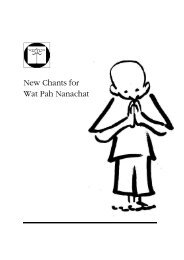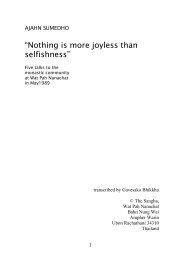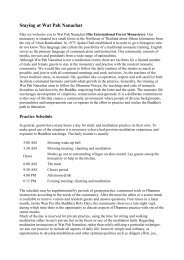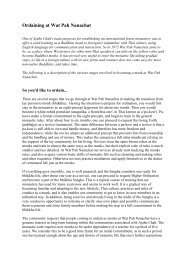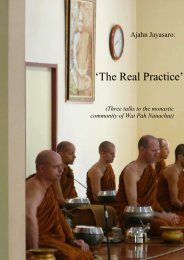Luang Por Liem: The Ways of the Peaceful - Wat Pah Nanachat
Luang Por Liem: The Ways of the Peaceful - Wat Pah Nanachat
Luang Por Liem: The Ways of the Peaceful - Wat Pah Nanachat
You also want an ePaper? Increase the reach of your titles
YUMPU automatically turns print PDFs into web optimized ePapers that Google loves.
Now I will tell you <strong>the</strong> basic meditation objects, as a means for<br />
you to train for liberation from <strong>the</strong> defilements. <strong>The</strong>y are given in<br />
Pali, just in <strong>the</strong> same way as <strong>the</strong> teachers <strong>of</strong> old have been passing<br />
<strong>the</strong>m down for many generations. Please repeat after me:<br />
“Kesa, loma, nakha, danta, taco,<br />
taco, danta, nakha, loma, kesa.” 4<br />
<strong>The</strong>se meditation objects <strong>the</strong> Buddha called <strong>the</strong> rootmeditation<br />
objects. <strong>The</strong>y provide a way for our mind to<br />
experience <strong>the</strong> fading away <strong>of</strong> <strong>the</strong> cravings and desires that stain<br />
our minds 5 .<br />
It is normal that <strong>the</strong> ordinary unenlightened being understands<br />
<strong>the</strong> experience <strong>of</strong> desires in a personal way. <strong>The</strong> Buddha wanted<br />
us to see desires as non-self, as non-personal, and to realize that<br />
<strong>the</strong>re is no “being” <strong>the</strong>re, just <strong>the</strong> existence <strong>of</strong> elements – material<br />
form that behaves according to <strong>the</strong> laws <strong>of</strong> nature and relies on its<br />
environment being in balance. <strong>The</strong>n things can come into being.<br />
Yet this doesn’t mean that <strong>the</strong>y are stable. <strong>The</strong>y exist in such a<br />
way that <strong>the</strong>re is change and alteration all <strong>the</strong> time. <strong>The</strong>y are not<br />
in a condition that permanently stays <strong>the</strong> same. <strong>The</strong>re needs to be<br />
arising, existing and ceasing. This way <strong>of</strong> being is what we call<br />
existence according to <strong>the</strong> laws <strong>of</strong> nature.<br />
Investigating <strong>the</strong>se root meditation objects leads us to seeing<br />
instability, non-sustainability and non-self, a way <strong>of</strong> being that is<br />
4 meaning: hair <strong>of</strong> <strong>the</strong> head, hair <strong>of</strong> <strong>the</strong> body, nails, teeth, skin; <strong>the</strong> five<br />
visible external components <strong>of</strong> <strong>the</strong> body that <strong>the</strong> Buddha taught to reflect on.<br />
5 “<strong>the</strong> desires that stain our minds” is a common idiom in Thai Dhamma<br />
talks. It captures <strong>the</strong> understanding that desires are defilements. <strong>The</strong> literal<br />
translation is: <strong>the</strong> desires that dye (or colour) our mind.<br />
23


